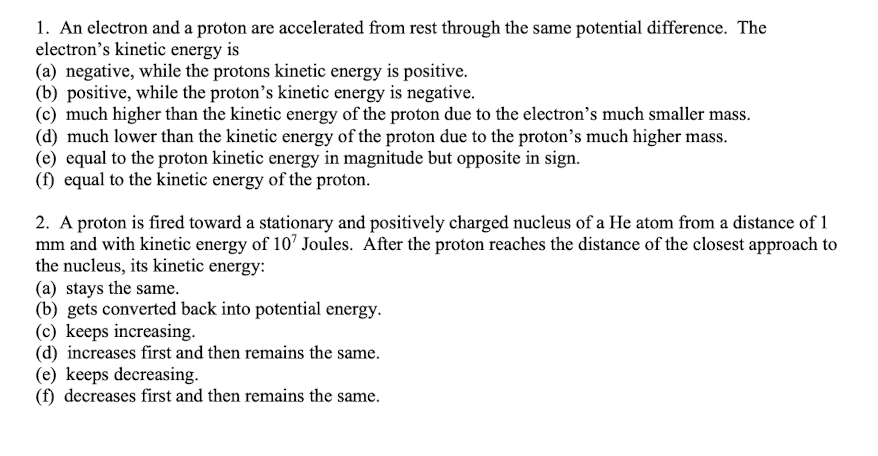1. An electron and a proton are accelerated from rest through the same potential difference. The electron's kinetic energy is (a) negative, while the protons kinetic energy is positive. (b) positive, while the proton’s kinetic energy is negative. (c) much higher than the kinetic energy of the proton due to the electron's much smaller mass. (d) much lower than the kinetic energy of the proton due to the proton's much higher mass. (e) equal to the proton kinetic energy in magnitude but opposite in sign. (f) equal to the kinetic energy of the proton.
1. An electron and a proton are accelerated from rest through the same potential difference. The electron's kinetic energy is (a) negative, while the protons kinetic energy is positive. (b) positive, while the proton’s kinetic energy is negative. (c) much higher than the kinetic energy of the proton due to the electron's much smaller mass. (d) much lower than the kinetic energy of the proton due to the proton's much higher mass. (e) equal to the proton kinetic energy in magnitude but opposite in sign. (f) equal to the kinetic energy of the proton.
Physics for Scientists and Engineers
10th Edition
ISBN:9781337553278
Author:Raymond A. Serway, John W. Jewett
Publisher:Raymond A. Serway, John W. Jewett
Chapter38: Relativity
Section: Chapter Questions
Problem 53CP
Related questions
Question

Transcribed Image Text:1. An electron and a proton are accelerated from rest through the same potential difference. The
electron's kinetic energy is
(a) negative, while the protons kinetic energy is positive.
(b) positive, while the proton's kinetic energy is negative.
(c) much higher than the kinetic energy of the proton due to the electron's much smaller mass.
(d) much lower than the kinetic energy of the proton due to the proton's much higher mass.
(e) equal to the proton kinetic energy in magnitude but opposite in sign.
(f) equal to the kinetic energy of the proton.
2. A proton is fired toward a stationary and positively charged nucleus of a He atom from a distance of 1
mm and with kinetic energy of 10' Joules. After the proton reaches the distance of the closest approach to
the nucleus, its kinetic energy:
(a) stays the same.
(b) gets converted back into potential energy.
(c) keeps increasing.
(d) increases first and then remains the same.
(e) keeps decreasing.
(f) decreases first and then remains the same.
Expert Solution
This question has been solved!
Explore an expertly crafted, step-by-step solution for a thorough understanding of key concepts.
This is a popular solution!
Trending now
This is a popular solution!
Step by step
Solved in 2 steps with 1 images

Knowledge Booster
Learn more about
Need a deep-dive on the concept behind this application? Look no further. Learn more about this topic, physics and related others by exploring similar questions and additional content below.Recommended textbooks for you

Physics for Scientists and Engineers
Physics
ISBN:
9781337553278
Author:
Raymond A. Serway, John W. Jewett
Publisher:
Cengage Learning

Physics for Scientists and Engineers with Modern …
Physics
ISBN:
9781337553292
Author:
Raymond A. Serway, John W. Jewett
Publisher:
Cengage Learning

Physics for Scientists and Engineers, Technology …
Physics
ISBN:
9781305116399
Author:
Raymond A. Serway, John W. Jewett
Publisher:
Cengage Learning

Physics for Scientists and Engineers
Physics
ISBN:
9781337553278
Author:
Raymond A. Serway, John W. Jewett
Publisher:
Cengage Learning

Physics for Scientists and Engineers with Modern …
Physics
ISBN:
9781337553292
Author:
Raymond A. Serway, John W. Jewett
Publisher:
Cengage Learning

Physics for Scientists and Engineers, Technology …
Physics
ISBN:
9781305116399
Author:
Raymond A. Serway, John W. Jewett
Publisher:
Cengage Learning

Principles of Physics: A Calculus-Based Text
Physics
ISBN:
9781133104261
Author:
Raymond A. Serway, John W. Jewett
Publisher:
Cengage Learning

College Physics
Physics
ISBN:
9781285737027
Author:
Raymond A. Serway, Chris Vuille
Publisher:
Cengage Learning

College Physics
Physics
ISBN:
9781305952300
Author:
Raymond A. Serway, Chris Vuille
Publisher:
Cengage Learning